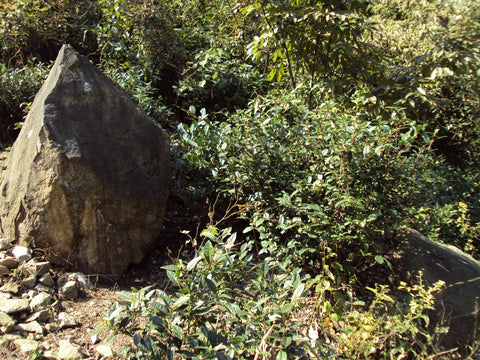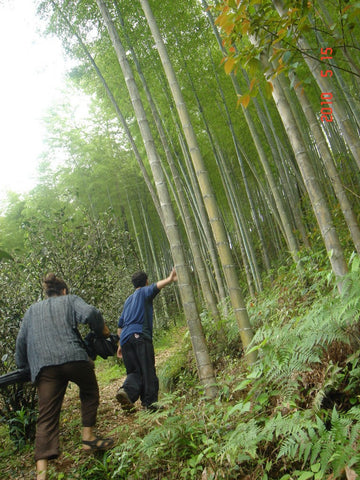
In my time in the tea industry I have bumped into a few non-believers or nay sayers about wild tea. They say things like:
A lot of this has to do with their motives more than the truth. For example, there were several "leading"; scientists in China making claims that wild tea was not real, although industry insiders believe they were backed by the major tea factories. Recently, I was asked about this by a well-known tea buyer in the US.
Please see his question below. While he raises common concerns, below his answer I show him how his (and public) perception was intentionally twisted against wild tea in the early 2000s by Big Tea and scientists for hire.
Here is his Question and our answer copied and pasted along with some other info:
"I have read [JT's Book] book and there are some major problems. The first is that, except for Yunnan, there have been no wild tea ever discovered. The cultivation of the small leaf tea began in Sichuan a bit more that 2000 years ago, and spread from there to the rest of China. Only in Yunnan is there truly indigenous tea plants.
What Mr. Hunter is call 'wild tea' is cultivated tea that has gone untended.Tea is a very hardy plant that will easily survive not being tended in a friendly environment and will grow into a small tree. A wild small leaf ancestor has never been discovered. It is one of the the major mysteries of tea biological history.
The second major problem is that Mr. Hunter suggests that untended tea plants, somehow are superior to the plants that are tended by a competent grower, that weeds his garden, trims, and nurtures his plants. He does mention at one point in the book that the drinking tea from a wild tea plants will cause you to get sick, which is true, which makes you wonder about the rest of what is said in the book about wild tea.
Clearly Mr. Hunter has spent a lot of time traveling around China and has spent a lot that time in tea growing areas, but factually there is no scientific basis to what he is claiming about 'wild tea'. The health claims that he makes of his website are not substantiated by research.
Clearly Mr. Hunter is passionate about tea, and cares deeply about what he is doing, and according to people that have tried his tea, is able to source some good tea. Jay, if you are reading this, I would like to refer you to Dr. Chen Ke Ke at the Kunming Institute of Botany, The Chinese Academy of Science. Is is one one the world's leading experts on wild and ancient tea.:
"[Mr. Tea Buyer], thanks for reading my book. Here is my reply to you:
I am glad you brought up Dr. Chen Keke 陈可可. I am very familiar with him actually already. In fact one of the ladies who works in my company knows him personally. There is much more to his research than meets the eye. To understand his research one must understand how he did his research. You must also understand his reputation is not the most reputable among many in the tea business in China. Please read below to understand:
Prior to 2008 the Puer business was very chaotic. Most tea buyers only purchased wild and ancient tea tree teas as they believed (and rightly so) that these were of the best quality. The result was a frenzy of over picking ancient tea trees and wild teas as they could see the difference between a traditional garden tea and wild and or ancient tree tea. Notably, the large tea factories were taking a beating.
As you know how it can go in China, many people began cheating the consumers by selling them fake ancient tea tree and wild teas that were actually just normal teas. This damaged the reputation of the whole industry as people started to realize what was happening and investigations began.
After the 2007 Puer bubble that exploded, in Yunnan lots of large factories began to shut down.
After this some major tea factories began to take action to reign the chaos that was ensuing and save their dying businesses. There were a few scientists that "conveniently"; and "timely"; came out with research showing that there were almost no wild and or ancient tea trees left. They said that the ones that were left would likely make you sick.
It is believed by many that these scientists were backed by several large tea factories as these factories used their research in all of their marketing in attempts to win back the consumers trust in their garden tea. If you look at Chen Ke Ke's work, he is backing several major tea factories for their hygiene. Many believe this was bought – as they say, everything (and everyone) in China has it's price.
Even still, his approval is continually sought after by many of the largest tea factories in Yunnan.
Now, in Yunnan Province, over 70% of the forest is gone because they are raping the forests to plant rubber, tea, and other mono-culture crops. In Sichuan, where your wife is from, the situation is almost worse.
I understand this might not be good news for those who are selling mass produced teas, but it is a dose of reality the average consumer should be waking up to when they purchase those products especially at a crucial time of environmental destruction that is occurring as we speak. Now the answer is not to go and pick just wild tea trees and over pick the ancient trees. The answer I believe lies in Biodiverse tea plantations and supporting these.
To expound further upon what I wrote above it is interesting to see this:
http://www.ynswcy.cn/Article_View.asp?id=965 [Note: This web page is no longer live]
This page discusses how Chen Ke Ke designed a kind of puer technology that was sold to a Yunnan tea company to use for produce puer tea. It is most interesting to note that this company was built up right after the 2007 puer tea crisis. This link shows exactly that Chen Ke Ke sold the technology to this company.
Finally, addressing the quote from my book that "drinking tea from wild trees makes you sick";. It is crucial when quoting someone's writing that you keep the context it was written in otherwise this can lead to many misunderstandings. The context I was speaking of is how that there is a variety of wild tea trees in Yunnan that cannot be consumed as it will make you sick. The locals know which ones these are and generally do not try to sell them. Actually, I know one harvester who uses this tea to help relieve constipation as it induces diarrhoea.
Here is a link to Wiki on some records of wild teas in China , but here is an excerpt from it:
In fact, in my book Wild Tea Hunter you will see plenty of examples of my wild tea hunting adventures and pics. Here are some pictures of wild Anji Bai Cha (Anji White Tea) tea bushes I found in while hiking in Anji after I was told by the farmer that I was staying with that there were wild tea bushes around the area.

Wild Anji White Tea Tree

Wild Anji White Tea Tree

Wild Anji White Tea Tree

Bamboo forest next to wild tea garden (left) Wuyishan
Like all industries, tea has it's virtuous producers and its crooks. We at WTQ have dedicated our lives over the last ten years to finding and selling only tea that meets are insane quality standards. Believe me, with what we know, we could make a hell of a lot more money doing it the mono-cultured, mass-produced way, as our contacts and global trade knowledge for tea are commensurate with any other tea company in the world.
But we believe in ecological justice and consumer health. I stand by the claims on all of our teas as wild and healthy, and I encourage you to reach out to us at any point for clarification.
Until next time,
JT Hunter
For Teas are not available online, you can contact us to get it especially for yourself: info@wildteaqi.com
Comments will be approved before showing up.